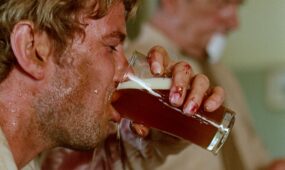Adelaide Film Festival review: Loving Vincent
Film & TV
Described as the first fully painted feature film, Loving Vincent is an innovative exploration of the life and death of one of the most celebrated painters of all time.

On July 29, 1890, the world lost one of its greatest artists, though very few people at the time knew that the artist or his work even existed.
Vincent van Gogh’s death was as tragic as his life. And while we know much about his life because of the many letters he wrote (published by his brother’s wife, Jo Bonger), his death has always been contentious.
Did he shoot himself? Was it madness or poverty or feelings of failure that drove him to it? Did someone else shoot him?
With the help of 125 painters creating 66,900 frames for the world’s first fully painted feature film, Loving Vincent poses these questions in true whodunnit style.
It’s two years after Van Gogh’s death and Armand Roulin is tasked with the job of delivering a newly discovered last letter from Vincent to his brother Theo. Because Theo, too, has died, the mission is not so straightforward, and once he begins the reluctant journey to find the right person to receive the letter, Armand is drawn into the mysteries surrounding Vincent’s death.
So what’s more famous: Van Gogh’s paintings or the tragedy of his life and death? It could be said that to appreciate one you must understand the other, and directors/screenwriters Dorota Kobiela and Hugh Welchman respectfully do just this.
Opening scenes focus on one of Van Gogh’s paintings. A moment later the painting begins to move (and anyone who has ever seen a Van Gogh painting will understand why this concept works so well – the artist is known for creating a vibrancy of movement in his work). Movement brings narrative and narrative opens up the story of a brilliant but hounded man.

Get InReview in your inbox – free each Saturday. Local arts and culture – covered.
Thanks for signing up to the InReview newsletter.
The main players in the film derive from Van Gogh’s portraits. There’s Armand Roulin and his father Joseph, Adeline Ravoux and Dr Gachet, among others. The actors who lend voices to these characters also lend their bodies, as the film was first shot as live action then, frame by frame, hand-painted over in oils.
The characters are stunning contrasts as foreground to the surrounding adaptations of the masterpieces, and it’s clever, so very, very clever.
This highly anticipated cinematic feat debuted in June this year at the French Annecy Animation Festival, winning the top festival prize, and one would imagine with a film this innovative there will be many more awards to come. But more than the promise of multiple accolades, Loving Vincent has succeeded in respectfully honouring the life, the death and the work one of the most celebrated painters of all time, and it’s a stroke of genius.
Loving Vincent is screening again at Palace Nova on October 14 as part of the Adelaide Film Festival. See more festival stories and reviews here.
Support local arts journalism
Your support will help us continue the important work of InReview in publishing free professional journalism that celebrates, interrogates and amplifies arts and culture in South Australia.
Donate Here






Comments
Show comments Hide comments